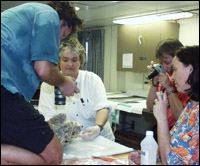Life between a rock and a hot place
Peering into Alvin's collection baskets on deck, Kelley made another discovery. There were tiny organisms embedded in some of the samples' delicate matrices. A search was made for surgical gloves, a precaution against contamination by human handlers, as a geological investigation suddenly became a biological one too.

Fig. 8. Expedition members photograph pieces of the chimney. Bobby Lee Williams, an Alvin pilot, Debbie Kelley, Barbara John, and Gretchen Frueh-Green take part (L-R).
"Normally, when I deal with biological samples after they have been fossilized," said Heather Hanna, a Duke graduate student in geochemistry, who found herself in an unfamiliar role: trying to preserve samples by freezing them at subzero temperatures.
Meanwhile, Kelley used tweezers to pry loose the inconspicuous and still-unidentified worm-like and anemone-like species, while Frueh-Green stood by with a bottle of alcohol, another means of preservation.
And Karson and Kelley carefully transferred vent fluids from Alvin's titanium collection containers into plastic bottles for cooling and for freezing. Those samples will be analyzed ashore for vent fluid chemistry and gases.

Parts of the vent structures were also frozen for later testing. They will be checked ashore for colonies of microbial life. If those are found, Kelley suspects they may be different, in both form and function, from microorganisms found at other vent locations.
Fig. 9. Debbie Kelley and Jeff Karson working together to extract vent fluid samples from one of Alvin's titanium collection containers.
That's because, at first glance, the water chemistry appears not to be of the iron and sulfur based kind that vent microbes elsewhere commonly use as energy, and vent structures also use as a source for building materials. Rocks at the new vent sites are made of peridotite somehow brought up from Earth's mantle. And peroditites are not generally a significant sulfur source, she said.
The usual bedrock at vent sites is made of volcanic basalt, which can provide plenty of sulfur and iron. Early tests on board Atlantis, however, suggest that the newly discovered vent structures are made of carbonate minerals and silica rather than the usual sulfides.
"We can only do primitive tests out here," Frueh-Green cautioned. One study simply involved scratching a piece of glass. Another involved dropping a sample fragment in hydrochloric acid. A third involved sniffing for telltale odors.
Today's pages:
"When I first saw them ..." | The towers | "... how little we know" | Life between a rock and a hot place | Plans for the lab back home

| 
|
|


